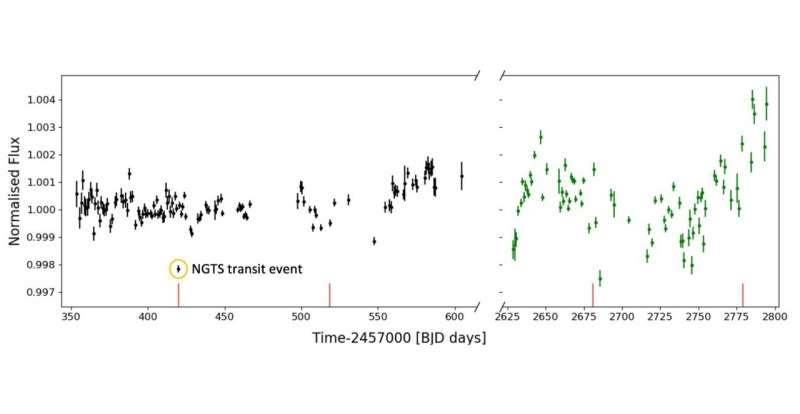April 9, 2024 report
This article has been reviewed according to Science X's editorial process and policies. Editors have highlighted the following attributes while ensuring the content's credibility:
fact-checked
preprint
trusted source
proofread
New young and warm Jupiter-like exoplanet detected

An international team of astronomers reports the detection of a new young and warm exoplanet orbiting a distant star. The newfound alien world, designated TOI-4862 b (or NGTS-30 b), is similar in size and mass to Jupiter. The finding was published April 3 on the pre-print server arXiv.
NASA's Transiting Exoplanet Survey Satellite (TESS) has identified more than 7,100 candidate exoplanets (TESS Objects of Interest, or TOI), of which 432 have been confirmed so far. Since its launch in April 2018, the satellite has been conducting a survey of about 200,000 of the brightest stars near the sun with the aim of searching for transiting exoplanets.
Recently, a group of astronomers led by Matthew Battley of the University of Geneva in Switzerland has confirmed another TOI monitored by TESS. They identified a transit signal in the light curve of TOI-4862—a young G-type star located some 762 light years away. The planetary nature of this signal was confirmed by follow-up observations.
"NGTS-30 b/TOI-4862 b was first discovered via a single transit in TESS photometry, before archival photometry from NGTS [Next Generation Transit Survey] and EulerCam were used to refine the planetary period," the researchers wrote in the paper.
TOI-4862 b has a radius of 0.93 Jupiter radii and its mass is approximately 0.96 Jupiter masses. The planet orbits its host every 98.3 days on a moderately eccentric orbit (with an eccentricity of 0.294), at a distance of 0.41 AU from it. Due to such eccentricity, equilibrium temperature TOI-4862 b likely varies from 274 to 500 K.
The parent star TOI-4862 is a few percent smaller and less massive than the sun and its age is estimated to be 1.1 billion years. The star has an effective temperature of approximately 5,455 K and its metallicity is at a level of -0.03 dex.
The obtained parameters make TOI-4862 b one of the youngest warm Jupiter so far discovered. Based on the interior modeling, the astronomers found that TOI-4862 b has a heavy element mass fraction of 0.23 and a heavy element enrichment of 20, which makes it metal-enriched compared to its host.
Summing up the results, the authors of the paper underlined the uniqueness of TOI-4862 b, proposing further investigation of this interesting extrasolar world.
"The star's age of 1.1 Gyr makes NGTS-30 b/TOI-4862 b one of the youngest warm Jupiters found, adding a crucial new system with which to understand the evolution timescale of such planets. Further observations of the spin-orbit angle and the atmosphere of this planet will help further define the migration history and composition of this interesting system," the scientists conclude.
More information: M. P. Battley et al, NGTS-30 b/TOI-4862 b: An 1 Gyr old 98-day transiting warm Jupiter, arXiv (2024). DOI: 10.48550/arxiv.2404.02974
Journal information: arXiv
© 2024 Science X Network





















